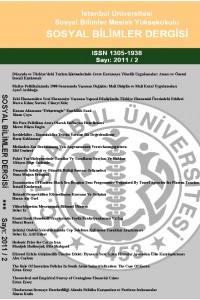Year 2011,
Issue: 2, 54 - 62, 10.04.2012
Abstract
ÖZET
İçeridekiler–dışarıdakiler teorisi, Yeni Keynesyen Okulun makroekonomik
analizlerinin dayandığı mikroekonomik temellerden biri olan reel ücret katılığı durumunu
açıklayan teorilerden biridir. Teori, işgücü piyasasında gayri iradi işsizlik
yapısının mevcut çalışma hayatında içeridekiler ve dışarıdakiler arasındaki farklı
çıkarlara dayandığını belirtmektedir. Bu çıkarların korunması amacı doğrultusunda,
işgücü piyasasında sendikalar ve sosyal normlar gibi çeşitli kurumların etkilerinin
de bulunduğu göz önünde bulundurulmaktadır. İçeridekiler–dışarıdakiler teorisi, işgücü
devir oranı maliyeti kapsamında işgücü piyasasında mevcut çalışan işçilerin,
dışarıda bulunan atıl işçilerden daha etkin olduğunu belirtmektedir.
Anahtar Sözcükler: Yeni Keynesyen Okul, İçeridekiler–Dışarıdakiler Teorisi,
İşgücü Devir Oranı Maliyeti
ABSTRACT
Insider – outsider theory is one of the explanation for the real wage rigidity
acconrding to understanding of the microeconomic fundamentals for the
macroeconomic analysis of New Keynesian School. Theory argued that the
structure of the involuntary unemployment through labour market relies on the
discrete economic rents of the insiders and outsiders. In order to conserve these
rents, labour unions and social norms have also significant importance in the labour
market. Theory suggest that turnover costs give substantive power to insiders than
outsiders throughout the negotiations with the employer.
Key Words: New Keynesian School, Insider–Outsider Theory, Turnover Cost
Keywords
References
- Lindbeck, Assar ve Snower, Dennis J.; (1986) "Wage Setting, Unemployment, and Insider-Outsider Relations", The American Economic Review, Vol. 76, No. 2, Papers and Proceedings of the Ninety-Eighth Annual Meeting of the American Economic Association, ss. 235-239.
- Lindbeck, Assar ve Snower, Dennis J.; (1988), "Long-Term Unemployment and Macroeconomic Policy", The American Economic Review, Vol. 78, No. 2, Papers and Proceedings of the One-Hundredth Annual Meeting of the American Economic Association, ss. 38-43.
- Lindbeck, Assar ve Snower, Dennis J.; (1988), "Cooperation, Harassment, and Involuntary Unemployment: An Insider-Outsider Approach", The American Economic Review, Vol. 78, No. 1, ss. 167ı 188.
- Lindbeck, Assar; (1988), "New Keynesianism and Aggregate Economic Activity", The Economic Journal, Vol. 108, No. 446, ss. 167-180.
- Lindbeck, Assar ve Snower, Dennis J.; (2001), "Insiders versus Outsiders", Journal of Economic Perspectives-Vol. 15, No. 1, ss. 165-188.
- Fine, Ben; (1998), Labour Market Theory, Routledge, New York, London.
- Snowdon, Brian ve Vane, Howard; (2005), Mo dern Macroeconomics, Edward Elgar Pub.
- Greenwald, Bruce ve Stiglitz, Joseph; (1993), "New and Old Keynesians", The Journal of Economic Perspectives, Vol. 7, No. 1 (Winter, 1993), ss. 23-44.
- Gollier, Christian; (1989), "Risk Sharing on the Labour Market: How to treat Young Generations?", Geneva Papers on Risk and Insurance, 14, ss. 25-53.
- Gollier, Christian; (1991), "Wage Differentials, the Insider-Outsider Dilemma, and Entry-Deterrence", Oxford Economic Papers, New Series, Vol. 43, No. 3, ss. 391-408.
- Doiron, Denise J.; (1995), "A Test of the Insider-Outsider Hypothesis in Union Preferences", Economica, New Series, Vol. 62, No. 247, ss. 281-290.
- Huizinga, F. ve Schiantarelli F.; (1992), "Dynamics and Asymmetric Adjustment in Insiderı Outsider Models", The Economic Journal, Vol. 102, No. 415, ss. 1451-1466.
- McDonald, I . ve Solow R.; (1981), "Wage Bargaining and Unemployment", American Economic Review, 71, ss. 896-908.
- De Vroey, Michel; (2004), Involuntary Unemployment, Routledge, London, New York, 2004, ss. 207-208.
Year 2011,
Issue: 2, 54 - 62, 10.04.2012
Abstract
References
- Lindbeck, Assar ve Snower, Dennis J.; (1986) "Wage Setting, Unemployment, and Insider-Outsider Relations", The American Economic Review, Vol. 76, No. 2, Papers and Proceedings of the Ninety-Eighth Annual Meeting of the American Economic Association, ss. 235-239.
- Lindbeck, Assar ve Snower, Dennis J.; (1988), "Long-Term Unemployment and Macroeconomic Policy", The American Economic Review, Vol. 78, No. 2, Papers and Proceedings of the One-Hundredth Annual Meeting of the American Economic Association, ss. 38-43.
- Lindbeck, Assar ve Snower, Dennis J.; (1988), "Cooperation, Harassment, and Involuntary Unemployment: An Insider-Outsider Approach", The American Economic Review, Vol. 78, No. 1, ss. 167ı 188.
- Lindbeck, Assar; (1988), "New Keynesianism and Aggregate Economic Activity", The Economic Journal, Vol. 108, No. 446, ss. 167-180.
- Lindbeck, Assar ve Snower, Dennis J.; (2001), "Insiders versus Outsiders", Journal of Economic Perspectives-Vol. 15, No. 1, ss. 165-188.
- Fine, Ben; (1998), Labour Market Theory, Routledge, New York, London.
- Snowdon, Brian ve Vane, Howard; (2005), Mo dern Macroeconomics, Edward Elgar Pub.
- Greenwald, Bruce ve Stiglitz, Joseph; (1993), "New and Old Keynesians", The Journal of Economic Perspectives, Vol. 7, No. 1 (Winter, 1993), ss. 23-44.
- Gollier, Christian; (1989), "Risk Sharing on the Labour Market: How to treat Young Generations?", Geneva Papers on Risk and Insurance, 14, ss. 25-53.
- Gollier, Christian; (1991), "Wage Differentials, the Insider-Outsider Dilemma, and Entry-Deterrence", Oxford Economic Papers, New Series, Vol. 43, No. 3, ss. 391-408.
- Doiron, Denise J.; (1995), "A Test of the Insider-Outsider Hypothesis in Union Preferences", Economica, New Series, Vol. 62, No. 247, ss. 281-290.
- Huizinga, F. ve Schiantarelli F.; (1992), "Dynamics and Asymmetric Adjustment in Insiderı Outsider Models", The Economic Journal, Vol. 102, No. 415, ss. 1451-1466.
- McDonald, I . ve Solow R.; (1981), "Wage Bargaining and Unemployment", American Economic Review, 71, ss. 896-908.
- De Vroey, Michel; (2004), Involuntary Unemployment, Routledge, London, New York, 2004, ss. 207-208.
There are 14 citations in total.
Details
| Primary Language | Turkish |
|---|---|
| Journal Section | Makaleler |
| Authors | |
| Publication Date | April 10, 2012 |
| Published in Issue | Year 2011 Issue: 2 |


